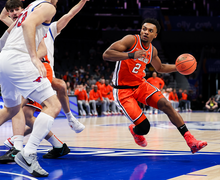University of Southern California game helps low-income students apply to college
A game aimed at helping low-income students prepare for college applications has received some additional help.
The University of Southern California’s Pullias Center for Higher Education has received a $3.2 million government grant to continue developing “Mission: Admission.” The game has students pick an avatar and juggle tasks involved in applying to college, like signing up for extracurricular activities, requesting letters of recommendation, writing essays and submitting the Free Application for Federal Student Aid.
Zoë Corwin, research director at the Pullias Center, said she was “thrilled” to learn about the grant, which will be implemented over four years.
“We know that we have something really exciting and effective, and the grant will enable us to scale up, to reach way more students than we’ve been able to research until this point,” she said. “It’s just really exciting.”
USC researchers are still fixing some of the problems with the game, one of which is its limited accessibility. The game is currently only available on Facebook, but Corwin said the new grant will help them transform the game into an app that can be accessed on a phone or computer.
“One of the challenges with the game is that you can’t use Facebook in schools, so it’s hard for teachers to use it as a tool in schools, and also it uses Flash Technology, and so you can’t play it on your phone,” Corwin said. “Those are two barriers to use that this new grant is going to give us the flexibility to change, so we’ll take it off Facebook and we’re going to make it accessible across multiple platforms.”
At the same time, Corwin said, the game developers have to keep in mind the technology limitations of low-income schools.
“We’re figuring out what devices are schools using and what operating systems, because, while we’d like to make something in the most recent operating system, it also most likely needs to be played in an older operating system, otherwise some of the computer labs won’t be able to access it,” she said.
Leslie Aaronson, a technology teacher at Foshay Learning Center in Los Angeles, has watched the “Mission: Admission” develop since the USC Game Innovation Lab began testing the game with her classes in 2008.
Aaronson said that she and her students see problems with the game, such as how long it takes for the game avatars to acquire energy to complete tasks. But she said that the game, by putting students through a simplified version of the college application process, teaches them time management skills and shows them what questions they need to ask.
“I do think it’s not for the kid who has parents on them to make sure they know what’s going on,” she said, but rather for low-income or first-generation college applicants who don’t have an at-home guidance on the application process.
Aaronson added that, for students, some of the most frustrating aspects of the game are also the most eye-opening.
“You might think that you’ve done everything to submit to a college, but if you haven’t asked for your letter of rec in time, then you can’t submit to the college and you’ve missed that deadline,” she said. “So that part of the game frustrates them, but that’s also the biggest connection they make. When it’s time to actually apply, they’re really on their deadlines because they’ve experienced so much failure in the game.”
Corwin said that’s one of the goals of the game: teaching students successful strategies by allowing them to experiment in the no-risk context of a game. She compared “Mission: Admission” to other strategy games like Monopoly or chess, which players have to play — and fail at — multiple times before they learn the most effective strategies.
Said Corwin: “We want students to learn college-going strategies in this safe place where they can mess up, and try again.”
Published on December 4, 2014 at 12:01 am
Contact Maggie: mmcregan@syr.edu





